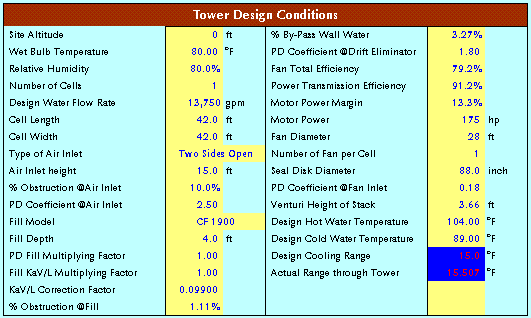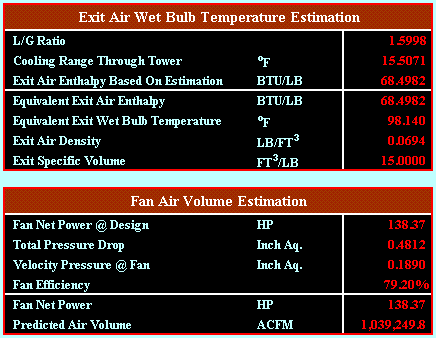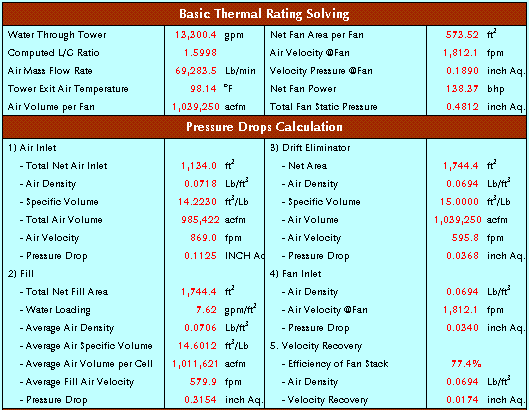|
The classical method of thermal rating of cooling tower
is to estimate the ratio of liquid to gas first and
is to find the proper tower volume by the means of trial
& error using the tower performance curve. This
was the most convenient solution when the computer was
not readily accessible. The major problems with this
solution are not to consider the actual geography. As
seen in the equations of NTU or Tower Demand, the right
side of formula is obviously a dimensionless factor.
It can be calculated using only the temperatures and
flows entering the tower. It is totally independent
from the tower size and fill configuration.
Now, the best way to design
the cooling tower is based on the actual sizes of tower
and is to find a proper L/G satisfying such sizes of
cooling tower. The L/G is the most important factor
in designing the cooling tower and related to the construction
& operating cost of cooling tower. The fooling example
will explain about the procedure of determining the
L/G ratio.
Example 14-1.
Determine the L/G ratio under the assumption that the
water flow rate was increased to 13,750 GPM and the
wet bulb temperature remains unchanged from design conditions
given in the example 13-1.
(Solution)

First, find a dry bulb temperature
for 80% of relative humidity corresponding 80oF
of wet bulb temperature at the tower inlet.
First Step: Find a
dry bulb temperature at the tower inlet.

Second Step: Find
an exit air temperature and air volume of fan. The procedure
is exactly same as the contents described in the example
13-1.
Net Fan Power = Motor HP
x (1 - Motor Margin) x Power Transmission Efficiency
Fan bhp = Air Volume @ Fan x Total Static Pressure /
(6356 x Fan Efficiency)
Exit Air Enthalpy = Inlet Air Enthalpy + L/G x Actual
Cooling Range
Actual Cooling Range = Design Range / (1 - % By-Pass
Water)
The iteration is continued
until the value of Net Fan Power equals to Fan bhp varying
air volume at the fan and the pressure drops corresponding
to the air volume at each location of cooling tower.
Net Fan Power = Fan bhp
That is, Motor HP x (1 - Motor Margin) x Power Transmission
Efficiency = Air Volume @ Fan x Total Static Pressure
/ (6356 x Fan Efficiency)
The air volume is finally
obtained from this relationship. Then, the L/G ratio
is obtained from below relations.
Water Flow Rate in gpm through
Tower = Design Water Flow Rate x (1 - % By-Pass Water
).
Water Flow Rate in Lb/Min = Water Flow Rate in gpm through
Tower x (500/60)
Air Mass Flow Rate = Air Volume @ Fan / Specific Volume
@ Fan
The L/G Ratio =Water Flow Rate in Lb/Min / Air Mass
Flow Rate in Lb/Min
Water Flow Rate in Lb/Min
= 13,300.4 x (500/60) = 110,836.7
Air Mass Flow Rate = 1,039,249.8 / 15.000 =69,283.3
L/G = 110,836.7 / 69,283.3
= 1.59976


Download
the example file, Version ID-THERMAL/TOWER (idthermal.zip)
This file is same as the example file discussed in example
13-1.
Example 14-2.
The value of slope in the tower characteristic was just
estimated like the above examples. Determine the actual
slope using the design conditions of the example no.13-1
and 14-1.
(Solution)
NTU = C x (L/G)-m
------------------------------ Eq.14-1
Log(NTU) = Log C - m x Log(L/G) -------------- Eq. 14-2
Log C = Log(NTU) + m x Log(L/G) -------------- Eq. 14-3
The fact, which that the
value of C for a designed cooling condition is same
regardless the change of water flow rate, was already
mentioned previously. From this rule, the value of slope
can be derived as follows;
Log C @ 100% Water = Log(NTU
@ 100% Water) + m x Log(L/G @ 100% Water) -- Eq. 14-4
Log C @ 110% Water = Log(NTU @ 110% Water) + m x Log(L/G
@ 110% Water) -- Eq. 14-5
Eq. 14-4 and Eq. 14-5 can
be written as below using the relation of Log C @ 100%
Water = Log C @ 110% Water.
Log(NTU @100% Water) + m x Log(L/G @ 100% Water) = Log(NTU
@ 110% Water) + m x Log(L/G @ 110% Water)
Log(NTU @100% Water) - Log(NTU @ 110% Water) = m x Log(L/G
@ 110% Water) - m x Log(L/G @ 100% Water)
This form can be changed
to:
Log(NTU @ 100% Water / NTU
@ 110% Water) = m x Log (L/G @ 110% Water / L/G @ 100%
Water)
Finally, this equation can
be solved for m as follows;
m = Log (NTU @ 100% Water
/ NTU @ 110% Water) / Log (L/G @ 110% Water / L/G @
100% Water)
| |
100%
OF WATER FLOW |
110%
OF WATER FLOW |
| L/G |
1.4413 |
1.5998 |
| NTU |
1.5149 |
1.3863 |
Slope = Log (1.5149 / 1.3863)
/ Log (1.5998 / 1.4413) = 0.8506
|